<Back to Index>
- Marshal of France Michel Ney, 1st Duc d'Elchingen, 1st Prince de la Moskowa, 1769
- Marshal of France Emmanuel de Grouchy, 2ème Marquis de Grouchy, 1766
PAGE SPONSOR
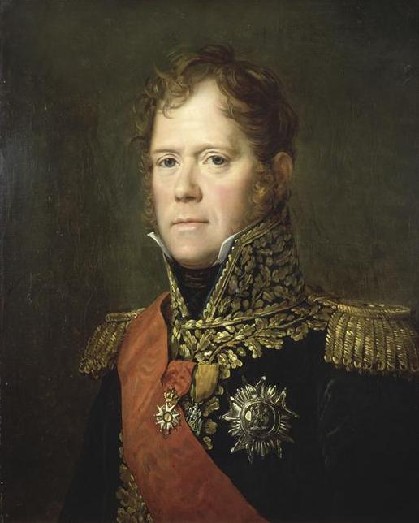
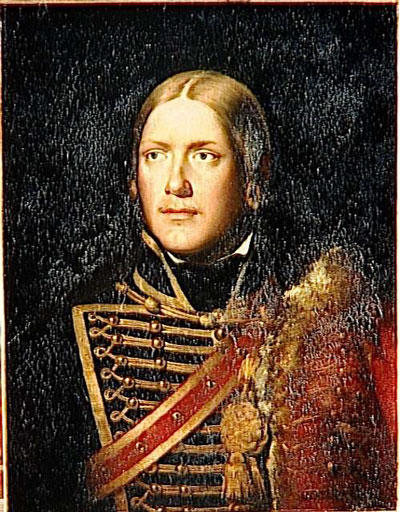
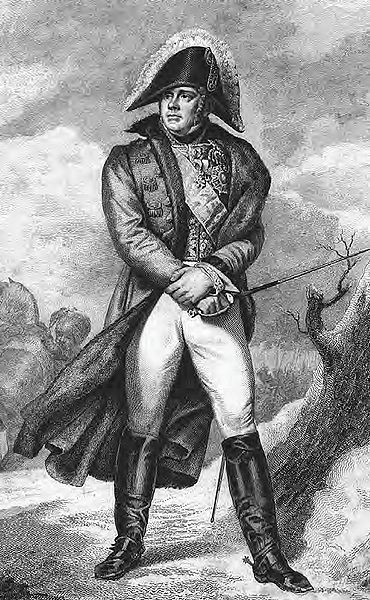
Michel Ney, 1st Duc d'Elchingen, 1st Prince de la Moskowa (10 January 1769 – 7 December 1815) was a French soldier and military commander during the French Revolutionary Wars and the Napoleonic Wars. He was one of the original 18 Marshals of France created by Napoleon I. He was known as Le Rougeaud ("red faced" or "ruddy") by his men and nicknamed le Brave des Braves ("the bravest of the brave") by Napoleon.
Michel Ney was born in Saarlouis, the second son of Pierre Ney (1738 – 1826), a master barrel cooper and veteran of the Seven Years' War, and of his wife Margarethe Grewelinger (1739 – 1791). Ney was the paternal grandson of Matthias Ney (1700 – 1780) and wife Margarethe Becker (d. 1767), and the maternal grandson of Valentin Grewelinger and wife Margaretha Ding. His hometown at the time of his birth comprised a French speaking enclave in a predominantly German speaking portion of Lorraine, and Ney grew up bilingual.
Ney was educated at the Collège des Augustins, and subsequently became a notary in Saarlouis, and then overseer of mines and forges.
Life as a civil servant did not suit Ney, and he enlisted in the Colonel General Hussar Regiment in 1787. Ney rapidly rose through the non - commissioned ranks. He served in the Army of the North from 1792 to 1794, with which he saw action at the Cannonade of Valmy, the Battle of Neerwinden, and other engagements. Ney was commissioned in October 1792, transferred to the Sambre - et - Meuse in June 1794, and wounded at the Siege of Mainz. Ney was promoted to général de brigade in August 1796, and commanded cavalry on the German fronts. On 17 April 1797, during the Battle of Neuwied, Ney led a cavalry charge against Austrian lancers trying to seize French cannons. The lancers were beaten back, but Ney’s cavalry were counter - attacked by heavy cavalry. During the mêlée, Ney was thrown from his horse and made a prisoner of war; on 8 May he was exchanged for an Austrian general. Following the capture of Mannheim, Ney was promoted to géneral de division in March 1799. Later in 1799, Ney commanded cavalry in the armies of Switzerland and the Danube. At Winterthur Ney received wounds in the thigh and wrist. After Ney’s recovery he fought at Hohenlinden under General Moreau in December 1800. From September 1802, Ney commanded French troops in Switzerland and performed diplomatic duties.
On 19 May 1804, Ney received his Marshal's baton, emblematic of his
status as a Marshal of the Empire, the Napoleonic era's equivalent of
Marshal of France. In the 1805 campaign Ney took command of VI Corps of La Grande Armée, and was praised for his conduct at Elchingen. In November 1805, Ney invaded the Tyrol, capturing Innsbruck from Archduke John. In the 1806 campaign, Ney fought at Jena and then occupied Erfurt. Later in the campaign, Ney successfully besieged Magdeburg. In the 1807 campaign Ney arrived with reinforcements in time to save Napoleon from defeat at Eylau, although the battle ended as a draw. Later in the campaign, Ney fought at Güttstadt, and commanded the right wing at Friedland. On 6 June 1808, Ney was created Duke of Elchingen.
In August 1808 Ney was sent to Spain in command of VI Corps, and won a
number of minor actions. In 1809 he routed an Anglo - Portuguese force
under Sir Robert Wilson at Baños. In 1810 Ney joined Marshal Masséna in the invasion of Portugal, where he took Ciudad Rodrigo from the Spanish and Almeida from the British and Portuguese, brusquely defeated the British on the River Côa, and fought at Buçaco. During the retreat from Torres Vedras, Ney worsted Wellington's forces in a series of lauded rearguard actions (Pombal, Redinha, Casal Novo,
Foz d'Aronce) with which he delayed the pursuing enemy forces enough to
allow the main French force to retreat unmolested. He was ultimately
removed from command for insubordination.
Ney was given command of III Corps of La Grande Armée during the 1812 invasion of Russia. At Smolensk, Ney was wounded in the neck, but recovered enough to later fight in the central sector at Borodino. During the retreat from Moscow, Ney commanded the rear guard and was anecdotally known as "the last Frenchman on Russian soil". After being cut off from the main army, Ney managed to rejoin it, which delighted Napoleon. For this action Ney was given the nickname "the bravest of the brave" by Napoleon. Ney fought at Beresina and helped hold the vital bridge at Kovno (modern day Kaunas), where legend portrays Ney as the last of the invaders to cross the bridge and exit Russia. On 25 March 1813, Ney was given the title of Prince of the Moskowa. During the 1813 campaign Ney fought at Weissenfels, was wounded at Lützen, and commanded the left wing at Bautzen. Ney later fought at Dennewitz and Leipzig, where he was again wounded. In the 1814 campaign in France, Ney fought various battles and commanded various units. At Fontainebleau Ney became the spokesman for the Marshals' revolt on 4 April 1814, demanding Napoleon's abdication. Ney informed Napoleon that the army would not march on Paris; Napoleon responded "the army will obey me!" to which Ney answered, "the army will obey its chiefs".
When Paris fell and the Bourbons reclaimed the throne, Ney, who had pressured Napoleon to accept his first abdication and exile, was promoted, lauded, and made a peer by the newly enthroned Louis XVIII. Although Ney had pledged his allegiance to the restored monarchy, the Bourbon court reacted coolly to his common origins.
When hearing of Napoleon’s return to France, Ney, determined to keep France at peace and to show his loyalty to Louis XVIII, organized a force to stop Napoleon’s march on Paris. Ney also pledged to bring Napoleon back alive in an iron cage. Napoleon was aware of Ney’s plans and sent him a letter which said, in part, ‘I shall receive you as after the Battle of the Moskowa’. Despite Ney’s promise to the King, he joined Napoleon at Auxerre, on 18 March 1815.
On 15 June 1815, Napoleon appointed Ney commander of the left wing of the Army of the North. On 16 June Napoleon's forces split up into two wings to fight two separate battles simultaneously. Ney attacked Wellington at Quatre Bras (and received criticism for attacking slowly) while Napoleon attacked Blücher's Prussians at Ligny. Although Ney was criticized for not capturing Quatre Bras early, there is still debate as to what time Napoleon actually ordered Ney to capture Quatre Bras. At Ligny, Napoleon ordered General d'Erlon to move his corps (currently on Napoleon's left and Ney's right) to the Prussians' rear in order to cut off their line of retreat. D'Erlon began to move into position, but suddenly stopped and began moving away, much to the surprise and horror of Napoleon. The reason for the sudden change in movement is that Ney had ordered d'Erlon to come to his aid at Quatre Bras. Without d'Erlon's corps blocking the Prussians' line of retreat, the French victory at Ligny was not complete, and the Prussians were not routed. To be fair, Ney was d'Erlon's direct superior and Napoleon never informed Ney of his plans.
At Waterloo
Ney was again in command of the left wing of the army. At around 3:30
p.m., Ney ordered a mass cavalry charge against the Anglo - Allied line.
Ney's cavalry overran the enemy cannons, but found the infantry formed
in cavalry - proof square formations. Ney, without infantry or artillery
support, was unable to break the squares. The action earned Ney
criticism, and some argue that it led to Napoleon’s defeat at Waterloo.
There is still debate as to the responsibility for the cavalry charge
and why it was unsupported. Ney’s cavalry also failed to spike enemy
cannons (driving an iron spike into the firing hole) while they were
under French control (during the cavalry attack, the crews of the cannon
retreated into the squares for protection, and then re-manned their
pieces as the horsemen receded). Ney’s cavalry carried equipment needed
to spike cannons, and spiking the cannons would likely have made them
useless for the rest of the battle. The loss of a large number of
cannons would weaken an army and could have caused the Anglo - Allied
force to withdraw from the battle.
Ney was seen during one of the charges beating his sword against the
side of a British cannon in furious frustration. During the battle he
had five horses killed under him.
When Napoleon was defeated, dethroned, and exiled for the second time in the summer of 1815, Ney was arrested (on 3 August 1815), and tried (4 December 1815) for treason by the Chamber of Peers. On 6 December 1815 he was condemned, and executed by firing squad in Paris near the Luxembourg Garden on 7 December 1815 – an event that deeply divided the French public. He refused to wear a blindfold and was allowed the right to give the order to fire, reportedly saying:
"Soldiers, when I give the command to fire, fire straight at my heart. Wait for the order. It will be my last to you. I protest against my condemnation. I have fought a hundred battles for France, and not one against her ... Soldiers, Fire!"
Ney's execution was an example intended for Napoleon's other marshals
and generals, many of whom were eventually exonerated by the Bourbon monarchy. Ney is buried in Paris at Père Lachaise Cemetery.
Ney married Aglaé Louise Auguié (Paris, 24 March 1782 – Paris, 1 July 1854) at Grignon on 5 August 1802 . Aglaé was the daughter of Pierre César Auguié (1738 – 1815) and Adélaïde Henriette Genet (1758 – 1794). Her paternal grandparents were Pierre César Auguié (1708 – 1776) and Marie Guary (1709 – 1788); her maternal grandparents were Edmé Jacques Genet (1726 – 1781) and Marie Anne Louise Cardon.
Ney and his wife had four sons:
- Joseph Napoléon, 2nd Prince de La Moskowa (Paris, 8 May 1803 – Saint - Germain - en - Laye, 25 July 1857). MarriedAlbine Laffitte (Paris, 12 May 1805 - Paris, 18 July 1881) in Paris on 26 January 1828, by whom he had issue. The male line of his descendants is now extinct. Joseph also had a bastard son who was married without issue.
- Michel Louis Félix, recognized as 2nd Duc d'Elchingen 1826 (Paris, 24 August 1804 – Gallipoli, during the Crimean War, 14 July 1854). He married Marie - Joséphine Souham (Luberzac, 20 December 1801 – Versailles, 1 July 1889) in Paris on 19 January 1833, by whom he had issue, with the male line becoming extinct in 1969.
- Eugène Michel (Paris, 12 July 1806 - Paris, 25 October 1845), who died unmarried and without issue.
- Edgar Napoléon Henry, recognized as 3rd Prince de La Moskowa 1857 (Paris, 12 April 1812 - Paris, 4 October 1882), who married Clotilde de La Rochelambert (Saint - Cloud, 27 July 1829 - Paris, 24 July 1867) in Paris on 16 January 1869, but died without issue; the title of Prince de la Moskowa then reverted to Michel's issue.
Immediately following Ney's execution, rumors concerning the nature of the Marshal's execution and its immediate aftermath began to surface. Among the facts that were presented by the Bourbon government to the public, such as those detailed in Parisian and Coalition military newspapers, several were purposely vague and unclear. Today there are still aspects of what is known about the execution that remain impossible to prove or disprove.
It is common among Napoleonic scholars and period experts to entertain a scenario where Marshal Ney had managed to escape to the United States. Proponents of this theory argue that Ney had Masonic ties, including to the Duke of Wellington, who helped him fake his execution and flee abroad. According to this account, the soldiers in the firing squad put blood packets over his heart and then shot blanks at the Marshal. He was then smuggled to the United States and continued his life as a school teacher.
In January of 1816, a man calling himself Peter Stuart Ney arrived in the United States by way of Charleston, South Carolina and disappears from record. In 1821, Ney resurfaces as a school master in Brownsville, South Carolina before relocating to Mocksville, NC. Between 1822 and 1828, Ney would hold semi - permanent teaching positions in several Carolina communities, including Hillsborough, Salisbury and Third Creek. He eventually made his way north into Virginia, spending some time there as the school master of Abbeyville in Mechlenburg County, but Ney would ultimately return to the Mocksville - Third Creek area.
Peter Stewart Ney died November 15, 1846 in Mocksville, North Carolina, aged 77 year Davidson College, where he designed the school seal still in use. He died in 1846, reportedly after uttering the final words, "Bessières is dead; the Old Guard is dead; now, please, let me die." On his gravestone in Cleveland, North Carolina, at Third Creek Presbyterian Church on Third Creek Church Road, one will find the words "(...) soldier of the French Revolution under Napoleon Bonaparte (...)."
The grave was exhumed in 1887 and a plaster cast made of the skull by a local doctor, though it was subsequently lost. In 1936, a letter sent to TIME magazine from a Charles W. Allison from Charlotte, North Carolina, claimed that the skull had been found in the doctor's family attic by his daughter. This skull, he reported, "shows evidence of having been scarred by bullets and swords".
In contrast to the relative plausibility of P. S. Ney's story, an early 19th century folk tale alleged that Michael Rudolph, a Continental Army officer in the American Revolutionary War, making his way to France after his forced resignation in 1793 and eventually becoming Ney.
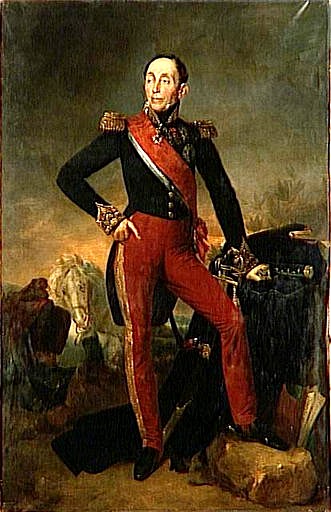
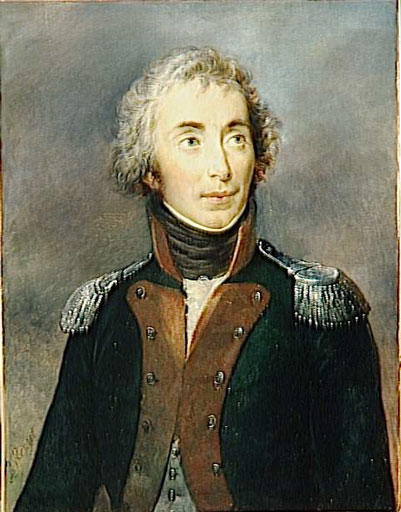
Emmanuel de Grouchy, 2ème Marquis de Grouchy (October 23, 1766 – May 29, 1847) was a French general and marshal.
Grouchy was born in Paris, the son of François - Jacques de Grouchy, 1st Marquis de Grouchy (b. 1715) and intellectual wife Gilberte Fréteau de Pény (d. 1793). His sister was Sophie de Condorcet, a noted feminist. He entered the French artillery in 1779; in 1782 he was transferred to the cavalry, and subsequently, in 1786, to the Gardes du Corps. In spite of his aristocratic birth and his connections with the court (as his father, having served as a page, was rumored to be the illegitimate son of king Louis XV), he was a convinced supporter of the principles of the Revolution, and had in consequence to leave the Guards. About the time of the outbreak of war in 1792 he became colonel of a cavalry regiment, and soon afterwards, as a maréchal de camp, he was sent to serve on the south - eastern frontier. In 1793 he distinguished himself in La Vendée, and was promoted Général de division. Grouchy was shortly afterwards deprived of his rank as being of noble birth, but in 1795 he was again placed on the active list. He served on the staff of the Army of Ireland (1796 – 1797), and took a conspicuous part in the Irish expedition. In 1798 he administered the civil and military government of Piedmont at the time of the abdication of the king of Sardinia, and in 1799 he distinguished himself greatly as a divisional commander in the campaign against the Austrians and Russians.
In covering the retreat of the French after the defeat of Novi, Grouchy received fourteen wounds and was taken prisoner. On his release he returned to France. In spite of his having protested against the coup d'état of the 18 Brumaire he was at once re-employed by the First Consul, and distinguished himself again at Hohenlinden. It was not long before he accepted the new régime in France, and from 1801 onwards he was employed by Napoleon in military and political positions of importance. He served in Austria in 1805, in Prussia in 1806, Poland in 1807, where he distinguished himself at Eylau and Friedland, Spain in 1808, and commanded the cavalry of the Army of Italy in 1809 in the Viceroy Eugène's advance to Vienna.
In 1812 he was made commander of one of the four cavalry corps of the Grande Armée, fought at Smolensk and Borodino and during the retreat from Moscow Napoleon appointed him to command the escort squadron, which was composed entirely of picked officers. His almost continuous service with the cavalry led Napoleon to decline in 1813 to place Grouchy at the head of an army corps, and Grouchy thereupon retired to France.
In 1814, however, he hastened to take part in the defensive campaign in France, and he was severely wounded at Craonne. At the Restoration he was deprived of the post of colonel general of Chasseurs à cheval and retired. In 1815, he joined Napoleon on his return from Elba, and was made marshal and peer of France. In the campaign of Waterloo he commanded the reserve cavalry of the army, and after Ligny he was appointed to command the right wing to pursue the Prussians.
Napoleon sent Grouchy to pursue a part of the retreating Prussian army under the command of General Johann von Thielmann. On 17th June, Grouchy was unable to close with the Prussians. Despite hearing the cannon sound from nearby Waterloo, he decided to follow the Prussians along the route literally specified in his orders while the Prussian and British - Dutch armies united to crush Napoleon. He won a smart victory over the one Prussian Corps in the Battle of Wavre, on 18 - 19 June 1815, but it was then too late, as by the time this battle was over, Napoleon had already lost at Waterloo.
So far as resistance was possible after the great disaster, Grouchy made it. He gathered up the wrecks of Napoleon's army and retired, swiftly and unbroken, to Paris, where, after interposing his reorganized forces between the enemy and the capital, he resigned his command into the hands of Marshal Davout.
The rest of his life was spent in defending himself. An attempt to have him condemned to death by a court martial
failed, but he was exiled and lived in America until amnestied in 1821.
On his return to France he was reinstated as general, but not as
marshal nor as peer of France. For many years thereafter he was equally
an object of aversion to the court party, as a member of their own caste
who had followed the Revolution and Napoleon, and to his comrades of
the Grande Armée as the supposed betrayer of Napoleon. In 1830 Louis Philippe gave him back the marshal's baton and restored him to the Chamber of Peers. He died at Saint - Étienne on May 29, 1847.
He was married firstly to Cécile Le Doulcet de Pontécoulant (1767 – 1827), by whom he had 4 children: Ernestine (1787 – 1866); Alphonse (1789 – 1864); Aimee - Clementine (1791 – 1826); Victor (1796 – 1864).
He married secondly Fanny Hua (1802 – 1889) and had 1 daughter: Noemie (1830 – 1843).